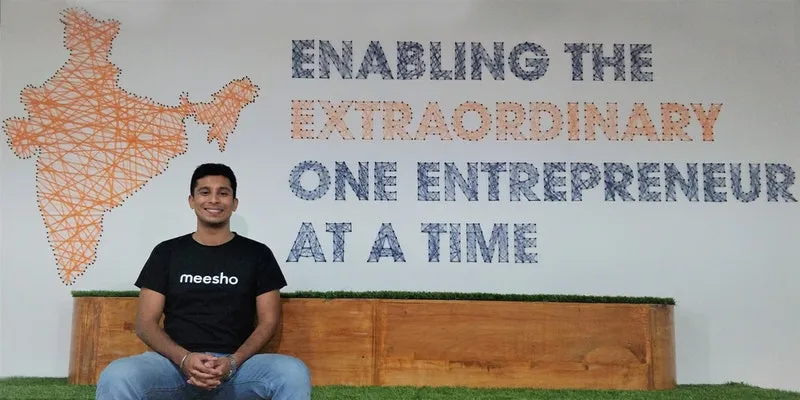Meesho’s business model sounded like a marketing gimmick to VCs initially, says CEO Vidit Aatrey
In this episode of 100X Entrepreneur podcast, Vidit Aatrey, Co-founder and CEO of social commerce platform Meesho, talks about how the startup has evolved over the years in its business model and GTM strategy.
Fundraising is not a child’s play. But the amount of time it took social commerce platform to raise series A funding, and the ambiguity that followed was extremely challenging for Vidit Aatrey, the CEO of Meesho.
Meesho got its first institutional funding of $3 million from SAIF Partners in 2017. This was followed by a $10 million round from Sequoia Capital. One thing led to another, and Facebook and Naspers joined the club.

Vidit Aatrey, Founder and CEO, Meesho
Vidit says, “That’s when I learned the most. But I also realised that a lot of people in India take time to understand a new model because there are not many new models here. Many large companies have been inspired by the West, with a lot of fundraising happening because of matching patterns."
After completing his BTech from IIT Delhi, Vidit worked with ITC and InMobi in the early days of his career. It was around 2015 when he decided to try out something new. While exploring other options, he came across the idea to create a platform where people could start and manage their business from the comfort of their home.
And this led to the birth of Meesho. Vidit was joined by Sanjeev Barnwal, and the company was set up in Bengaluru in 2015. Meesho, which literally means ‘Meri Shop’ (my shop), provides potential entrepreneurs with a virtual shop, who otherwise would find it difficult to start a business.
Today, Meesho has more than two million sellers across 700 towns in India on its platform. It also provides distribution access to another 20,000 manufacturers through its platform.
This is perhaps the reason why Meesho caught Facebook’s attention, and became the first Indian company to be backed by the social media giant.
An investors’ darling, the startup has raised $215.2 million till now. Meesho is today backed by some of the most prominent names in the country and across the world including Y Combinator, Facebook, Naspers, SAIF Partners, Sequoia, Shunwei Capital, and RPS.
Listen more to what Vidit had to say as he spoke to Siddhartha Ahluwalia, Head of Community at Prime Venture Partners, on an episode of 100X Entrepreneur podcast, a series featuring founders, venture capitalists, and angel investors.
Tune in to listen to Vidit in conversation with Siddhartha:
A business model that is not me-too
Vidit and Sanjeev had to face a lot of resistance from investors initially while they were trying to raise institutional funding. Though a lot of people did not believe in their business model, considering it was new, one thing that really worked for Meesho was the traction. While the startup was unable to raise any money, it still kept growing at a rapid pace.
The investors who kept saying no to the startup were suddenly reconsidering their decision because the numbers were growing. Around 2016 and 2017, the idea of selling on WhatsApp was very fresh, and nobody had tried it.
“Any startup which is trying to do something super bold and something very new, comes off as not very understandable because they are very new. Meesho sounded like a marketing gimmick, a fad that exists this year and will go away tomorrow,” says Vidit.
There were questions around why won’t users just go and buy on Amazon and Flipkart. And yet, the VC industry did not understand how a lot of community commerce happens offline. As the numbers grew, Meesho kept going back to the VCs while constantly sharing the updates.
Vidit said he eventually realised that a lot of VCs acknowledged that Meesho can be a large opportunity, and things just got better after that. He was clearly able to communicate that Meesho’s users showed an immense amount of gratitude because it had changed their lives in so many ways.
The go-to-market strategy
Vidit says, the team has always been creative when it came to taking the product to the market. Even now, a good chunk of its user base, about 10 percent of all the user acquisition, happens through influencers on YouTube and Instagram. These influencers are locals in Tier II, III, and IV cities who talk about opportunities to people who don’t really know about them.
“We have a large user base who are women, and they are active on social platforms. And it’s not a lot of effort telling other people in your family about this opportunity. That was really one of the big ways of how we could grow so fast. So, leveraging referrals where people recommended people in their own family was a big fit for us to grow.”
For the next 100 or 500 million users, Vidit says, platforms like TikTok, WhatsApp, and Facebook are huge opportunities, and Instagram is fast approaching to be a mega channel.
(Edited by Megha Reddy)









